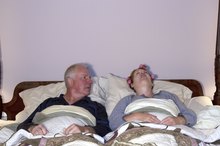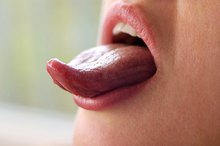What does fact checked mean?
At Healthfully, we strive to deliver objective content that is accurate and up-to-date. Our team periodically reviews articles in order to ensure content quality. The sources cited below consist of evidence from peer-reviewed journals, prominent medical organizations, academic associations, and government data.
The information contained on this site is for informational purposes only, and should not be used as a substitute for the advice of a professional health care provider. Please check with the appropriate physician regarding health questions and concerns. Although we strive to deliver accurate and up-to-date information, no guarantee to that effect is made.
How to Prevent Loose Jowls & Sagging Facial Skin
Most people who work out in gyms or in the home spend plenty of time on the arms, legs and torso, but usually forget exercises specifically for the face and neck muscles. For some reason, people seem to forget that these muscles also need to be exercised on a regular basis in order to maintain a healthy muscle tone. Exercising the lower face and chin and jaw muscles may help prevent jowls or loose, sagging skin around the jawline as you age.
Sit or stand in a relaxed, comfortable position and then gently tilt your head backward, like you're relaxing completely. With the chin tilted back, try to lift your lower lip over your top lip. Once you have it as far as you can stretch, hold the position for about five seconds. Then relax the lips but keep the chin tilted up. Practice the exercise with the lips four more times. You can do this exercise two to three times a day.
Is It Possible to Tighten Sagging Skin Under the Chin?
Learn More
Practice sticking out your tongue (when you're alone and in private, of course). Now, tilt your head backward and look at the ceiling. Stick that tongue out, pointing upward toward the ceiling as well. You will feel the stretch and pull not only at the back of the tongue, but all along the front of the neck and underneath the jaw or chin line. Hold the position for about five seconds and then relax. Repeat this exercise three or four more times as comfortable. You can repeat this exercise several times a day if you wish.
Lie down on your back on your bed or a sofa, with your head hanging down over the end, face turned upward facing the ceiling 1. Arms should be at your sides, your body relaxed and comfortable. Slowly and evenly, lift your head upward until it is even with the rest of your body. You should feel this exercise all around the front of the throat and you may even feel a pull at the back of your head near your neck. This is because your body is not used to lifting the head in this position. Hold the head in this position for a count of 10 if you can, five seconds if you feel any discomfort. Relax. Repeat the exercise several more times. You can extend the hold time to 10 or 15 seconds as you grow stronger.
Exercises to Completely Stop Snoring
Learn More
Stand or sit, and place one fist under the bottom of your chin. Now, keeping pressure lifting upward with the fist, open your mouth and lower your jaw, pressing against your hand. You can do this move fairly quickly, shooting for opening your mouth between 10 and 20 times. This is a facial exercise described in a video by Jack LaLanne in the 1950s that is still effective today. See the link for a YouTube video describing this exercise.
Related Articles
References
- "Forget the Facelift: Turn Back the Clock with a Revolutionary Program for Ageless Skin"; Doris J. Day, Sondra Forsyth
- Cleveland Clinic: Facelifts
- JackLaLane: Face Workout 18 of 30
- Johns Hopkins Arthritis Center. Ankylosing Spondylitis. Updated: August 28, 2017
- National Ankylosing Spondylitis Society UK. Exercise for your AS. Updated: February 27, 2017.
- Reveille JD. Epidemiology of Spondyloarthritis in North America. Am J Med Sci. 2011 Apr; 341(4): 284–286. DOI: 10.1097/MAJ.0b013e31820f8c99.
- Spondylitis Association of America. Exercise & Posture.
Writer Bio
Denise Stern is an experienced freelance writer and editor. She has written professionally for more than seven years. Stern regularly provides content for health-related and elder-care websites and has an associate and specialized business degree in health information management and technology.







